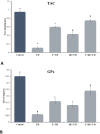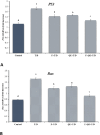The synergistic activity of fisetin on quercetin improves testicular recover in ischemia-reperfusion injury in rats
- PMID: 40199993
- PMCID: PMC11978994
- DOI: 10.1038/s41598-025-96413-9
The synergistic activity of fisetin on quercetin improves testicular recover in ischemia-reperfusion injury in rats
Abstract
This study examines a potential treatment for testicular ischemia-reperfusion (I/R) injury using fisetin (FIS) and quercetin (QUE) in a rat model. Male rats were divided into five groups: a control group, a torsion/detorsion (T/D) group, and three experimental groups treated with FIS, QUE, or a combination of FIS + QUE. Sperm parameters, oxidative stress markers, histopathological features, RT-PCR analysis of apoptotic and antiapoptotic gene expression, and fertility index were evaluated. The results demonstrated that FIS + QUE, FIS, and QUE significantly improved sperm motility and concentration, leading to a higher fertility index, than the reduced metrics in the T/D group. Additionally, levels of MDA and NO were significantly lowered, while CAT, SOD, GPx, and TAC levels increased in the FIS + QUE, FIS, and QUE groups. Histopathological, RT-PCR and fertility analyses also revealed evidence of apoptosis and testicular damage in the T/D group, shown by significant increases in P53, Bax, and caspase-3, along with marked decreases in AKT, PI3K, and Bcl-2. Treatment with FIS and QUE, particularly in combination, significantly improved outcomes, indicating a strong synergistic effect that helps repair damage and enhance reproductive function after T/D injury.
Keywords: Fisetin; Ischemia-reperfusion; Oxidative stress; Quercetin; Rat; Testicular torsion.
© 2025. The Author(s).
Conflict of interest statement
Declarations. Competing interests: The authors declare no competing interests. Ethics approval and consent to participate: The Animal Ethics Committee of Urmia University approved the experiments, and all methods were carried out in accordance with the relevant guidelines and regulations (IR-UU-2361/PD/3). Additionally, the study adhered to the ARRIVE guidelines (Animals in Research: Reporting In Vivo Experiments) and complied with institutional and national regulations for the care and use of laboratory animals.
Figures









Similar articles
-
Effect of quercetin and mirtazapine on spermatogenesis and testis structure in phenylhydrazine-induced hemolytic anemia mice: An experimental study.Food Chem Toxicol. 2024 Jul;189:114732. doi: 10.1016/j.fct.2024.114732. Epub 2024 May 11. Food Chem Toxicol. 2024. PMID: 38740240
-
Protective Effects of Bromelain in Testicular Torsion-Detorsion: Reducing Inflammation, Oxidative Stress, and Apoptosis While Enhancing Sperm Quality.Biomolecules. 2025 Feb 15;15(2):292. doi: 10.3390/biom15020292. Biomolecules. 2025. PMID: 40001595 Free PMC article.
-
Nitroglycerin ameliorates sperm parameters, oxidative stress and testicular injury following by testicular torsion/detorsion in male rats.Exp Mol Pathol. 2020 Dec;117:104563. doi: 10.1016/j.yexmp.2020.104563. Epub 2020 Nov 2. Exp Mol Pathol. 2020. PMID: 33147433
-
Synergistic effect of rapamycin and metformin against germ cell apoptosis and oxidative stress after testicular torsion/detorsion-induced ischemia/reperfusion in rats.Biomed Pharmacother. 2018 Sep;105:645-651. doi: 10.1016/j.biopha.2018.06.012. Epub 2018 Jun 11. Biomed Pharmacother. 2018. PMID: 29902763
-
Proanthocyanidin alleviates testicular torsion/detorsion-induced ischemia/reperfusion injury in rats.Tissue Cell. 2024 Aug;89:102459. doi: 10.1016/j.tice.2024.102459. Epub 2024 Jul 8. Tissue Cell. 2024. PMID: 39002290
Cited by
-
The effects of heavy smoking on oxidative stress, inflammatory biomarkers, vascular dysfunction, and hematological indices.Sci Rep. 2025 May 25;15(1):18251. doi: 10.1038/s41598-025-03075-8. Sci Rep. 2025. PMID: 40415015 Free PMC article.
-
Allicin and hesperidin protect sperm production from environmental toxins in mice.Sci Rep. 2025 Apr 24;15(1):14224. doi: 10.1038/s41598-025-97730-9. Sci Rep. 2025. PMID: 40274915 Free PMC article.
References
-
- Ünsal, A. et al. Propofol attenuates reperfusion injury after testicular torsion and detorsion. World J. Urol.22, 461–465 (2004). - PubMed
-
- Howe, A. S. & Palmer, L. S. Testis torsion: recent lessons. Can. J. Urol.23, 8602 (2016). - PubMed
-
- Perrotti, M., Badger, W., Prader, S. & Moran, M. E. Medical malpractice in urology, 1985 to 2004: 469 consecutive cases closed with indemnity payment. J. Urol.176, 2154–2157 (2006). - PubMed
-
- Tamamura, M. et al. Protective effect of Edaravone, a free-radical scavenger, on ischaemia‐reperfusion injury in the rat testis. BJU Int.105, 870–876 (2010). - PubMed
-
- Shimizu, S. et al. Testicular torsion–detorsion and potential therapeutic treatments: A possible role for ischemic postconditioning. Int. J. Urol.23, 454–463 (2016). - PubMed
MeSH terms
Substances
LinkOut - more resources
Full Text Sources
Research Materials
Miscellaneous

